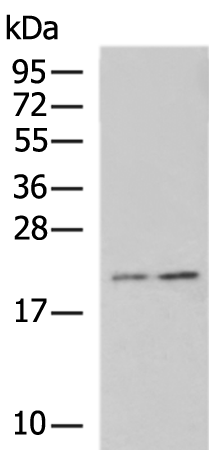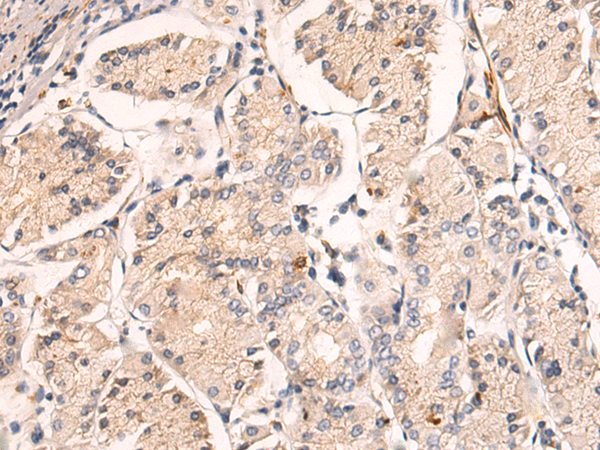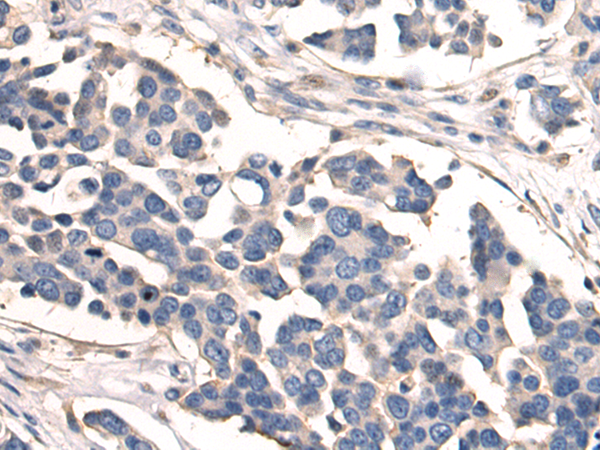


| WB | 咨询技术 | Human,Mouse,Rat |
| IF | 咨询技术 | Human,Mouse,Rat |
| IHC | 1/50-1/100 | Human,Mouse,Rat |
| ICC | 技术咨询 | Human,Mouse,Rat |
| FCM | 咨询技术 | Human,Mouse,Rat |
| Elisa | 1/5000-1/10000 | Human,Mouse,Rat |
| Aliases | PMLP; TM4SF11 |
| WB Predicted band size | 20 kDa |
| Host/Isotype | Rabbit IgG |
| Antibody Type | Primary antibody |
| Storage | Store at 4°C short term. Aliquot and store at -20°C long term. Avoid freeze/thaw cycles. |
| Species Reactivity | Human, Mouse, Rat |
| Immunogen | Fusion protein of human PLLP |
| Formulation | Purified antibody in PBS with 0.05% sodium azide and 50% glycerol. |
+ +
以下是关于PLLP抗体的示例参考文献(内容为示例性概括,建议通过学术数据库检索最新文献):
---
1. **文献名称**:*"PLLP as a Novel Target in Breast Cancer: Antibody Development and Functional Analysis"*
**作者**:Zhang Y, et al.
**摘要**:研究开发了针对PLLP(前列腺特异性脂蛋白类似蛋白)的单克隆抗体,发现其在乳腺癌细胞系中高表达,抗体通过抑制PLLP介导的信号通路显著降低肿瘤细胞侵袭能力。
2. **文献名称**:*"Autoantibodies Against PLLP in Neurological Disorders: A Cross-Sectional Study"*
**作者**:Müller S, et al.
**摘要**:探讨PLLP抗体在多发性硬化症患者血清中的检出率,提示其可能与髓鞘损伤相关,为自身免疫性神经疾病的生物标志物研究提供依据。
3. **文献名称**:*"Engineering a Humanized Anti-PLLP Antibody for Targeted Drug Delivery"*
**作者**:Kim T, et al.
**摘要**:报道了一种人源化PLLP抗体的构建,该抗体可特异性结合肿瘤细胞表面PLLP,并成功用于搭载化疗药物,提高癌症治疗的靶向性。
4. **文献名称**:*"PLLP Expression and Antibody-Based Detection in Prostate Cancer Progression"*
**作者**:Johnson RB, et al.
**摘要**:分析PLLP在前列腺癌不同阶段的表达水平,验证其抗体在组织切片中的诊断效能,表明PLLP可能成为预后评估的新指标。
---
**注意**:以上文献为示例性质,具体研究请通过PubMed、Google Scholar等平台以关键词“PLLP antibody”或“proteolipid protein-like protein antibody”检索最新成果。
Proteolipid protein (PLP), a major component of myelin in the central nervous system (CNS), plays a critical role in maintaining myelin structure and stability. PLP antibodies target this transmembrane protein and are primarily associated with autoimmune demyelinating disorders. Research has highlighted their relevance in diseases like multiple sclerosis (MS) and neuromyelitis optica spectrum disorders (NMOSD), where immune-mediated damage to myelin leads to impaired nerve signaling. PLP antibodies are thought to contribute to pathogenesis by binding to myelin sheaths, triggering inflammation, or disrupting axonal integrity. However, their diagnostic specificity remains debated, as PLP reactivity is also observed in healthy individuals or non-inflammatory neurological conditions.
Studies using animal models, such as experimental autoimmune encephalomyelitis (EAE), have demonstrated that PLP peptides can induce autoimmune responses, reinforcing its role as a potential autoantigen. Clinically, detecting PLP antibodies (often alongside other myelin-targeting antibodies like anti-MOG or anti-AQP4) aids in differentiating CNS demyelination subtypes, though their standalone diagnostic value is limited. Recent advances in epitope mapping and antibody characterization aim to refine their pathological significance. Despite ongoing research, PLP antibodies remain a focus in understanding autoimmune neuroinflammation and developing targeted therapies for myelin-related disorders.
×